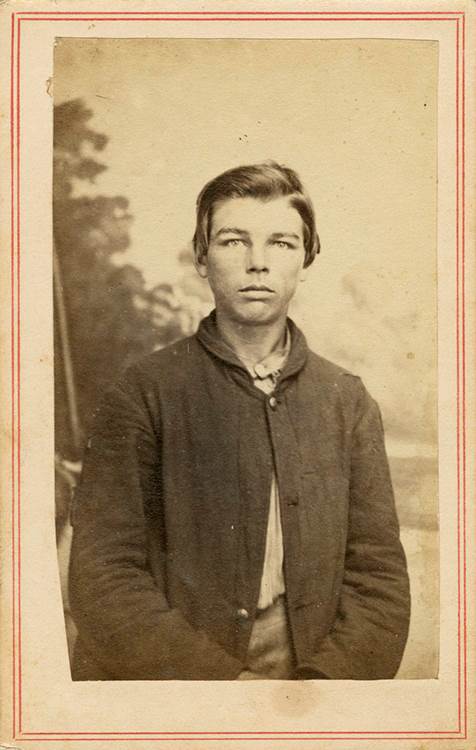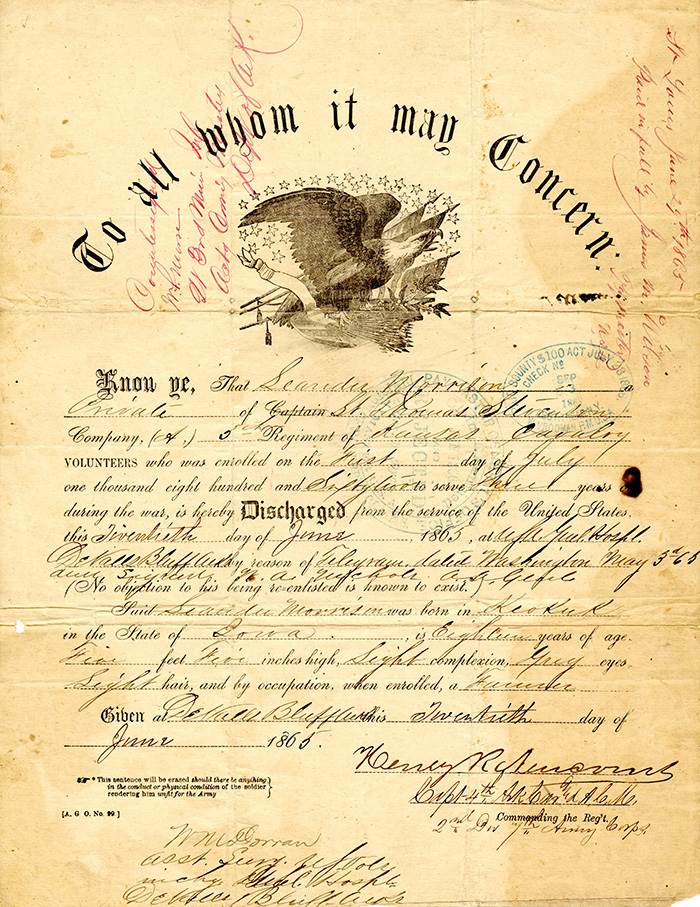By Michelle Miller
Every manuscript collection has something unique about it, telling at least a piece of the story of someone’s life. The Piggott Family Papers are no exception.
Donated to the Illinois State Historical Library (the predecessor of the presidential library) in the latter half of the 1970s, the Piggott Family Papers add to the story of Captain James Piggott, an early settler who came to Illinois in the 18th century, and his family and descendants. Included in the papers, you can find bits of the everyday lives of the Piggott family, as well as documents that feature prominent early Americans and Illinoisans – William Henry Harrison, William Clark (of Lewis & Clark fame) and Joseph Smith, just to name a few.
As I worked to arrange the Piggott Collection, one innocuous document caught my eye. It was a military discharge dated from 1865, noting the honorable discharge of a young man named Leander Morrison, aged just 18. As someone who was, by now, feeling well-versed in the Piggott family tree, I didn’t recall seeing a Leander Morrison – or indeed, any Morrisons or Morrises, as he is sometimes called – among the names. So who was he, and why was his discharge paperwork included with all these family items? It didn’t quite fit, and that stirred my curiosity.
I began, as most do in today’s world, by trying to search online for more information. I dug into his military record, and found the unit he had served in, and unexpectedly, located a photo of him, digitized by a project in Kansas. He was strikingly young in the photograph, clearly just a boy. His records said he enlisted in 1862 – if his age on the discharge was right, that would mean he had only been about 15. Something about that thought captivated me. He was far from the only young man to serve in the Civil War, but that made it no less surprising.
 Leander Morrison as a soldier with the 5th Kansas Cavalry. (kansasmemory.org, Kansas State Historical Society, Copy and Reuse Restrictions Apply.)
Leander Morrison as a soldier with the 5th Kansas Cavalry. (kansasmemory.org, Kansas State Historical Society, Copy and Reuse Restrictions Apply.)
I searched census records, military records, and burial records. The latter jumped out, as I was surprised to find that Leander Morrison was buried alongside several members of the immediate family of Isaac Newton Piggott, at Bellefontaine Cemetery in St. Louis. The collection of Piggott papers also had a document detailing the purchase of this family plot in 1873 – this was a year after Leander had died, at just 24 or 25, in a hospital for sailors in St. Louis who had nowhere else to go.
My first step was to reach out to the cemetery office itself and inquire about records, which told me a little more – that Leander had been moved purposefully into the Piggott plot after its purchase. He had to mean something to the family, or else why would they have moved him?
After this point, I ran into some dead ends in my searching. The library had closed because of the COVID-19 pandemic, and I had other things on my mind. However, as strange as it may sound, I could not shake the thought of Leander Morrison – his young face and his mysterious connection to the collection.
As time went on, I decided to ask more questions and reached out again, this time to the public library in Keokuk, Iowa – the town given as Leander’s birthplace – and decided to ask if they had any other ideas or leads. We had a long, conversation over email that pointed to a few more family members, though still no Piggott connection. I even asked my mom at home for help, picking her brain when it came to her genealogy expertise!
Ultimately, I still haven’t found the connection to the Piggott family. It could be that he was a cousin or a relative by marriage that I haven’t figured out yet. Less likely, but still possible, is that he was just a young man in the area that the Piggotts became acquainted with and ended up looking after. It may be that the records simply aren’t there, and we might never know.
 Morrison's discharge answers some questions about him, but many gaps remain. (ALPLM)
Morrison's discharge answers some questions about him, but many gaps remain. (ALPLM)
However, the experience did teach me the value of working with other resources – both materials and people – and how sometimes just bouncing ideas off someone else or reaching out when you have questions can be more valuable than anything else. It taught me, too, how even one document which seems insignificant has a story behind it – a person who lived in our past and in some small way, shaped our world.
After all of this, I’m able to tell the story – or part of it, at least – of one young man who may have been forgotten:
Leander Morrison was probably born in 1847 in Keokuk, Iowa. In 1860, aged 13, he was working as a staff member at the mansion of Alexander Heaslip, a Keokuk businessman. If he had any family left in Keokuk, he didn’t live with them, though he may have had an older brother named Romulus. By 1862, he had moved to either Arkansas or Missouri, and on July 1 he enlisted in the Union Army – just 15 years old. He spent 3 years as a private in the 5th Kansas Cavalry, a unit that served primarily in Arkansas during the Civil War, and was discharged at age 18. Sometime after the war, he seems to have found work as the pilot of a boat. It seems he was probably unmarried and had no children. He died at the age of 24 or 25 on June 22, 1872, of tuberculosis.
He was buried in Bellefontaine Cemetery, where he still rests today, beside the family of Isaac Newton Piggott.
Miller is a manuscripts librarian at the Abraham Lincoln Presidential Library and Museum.
# # #